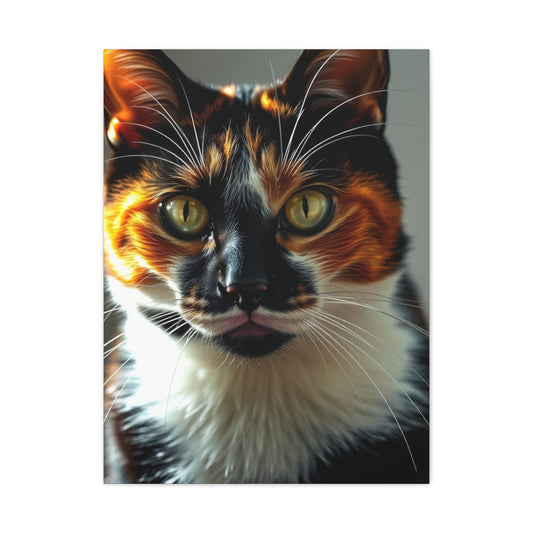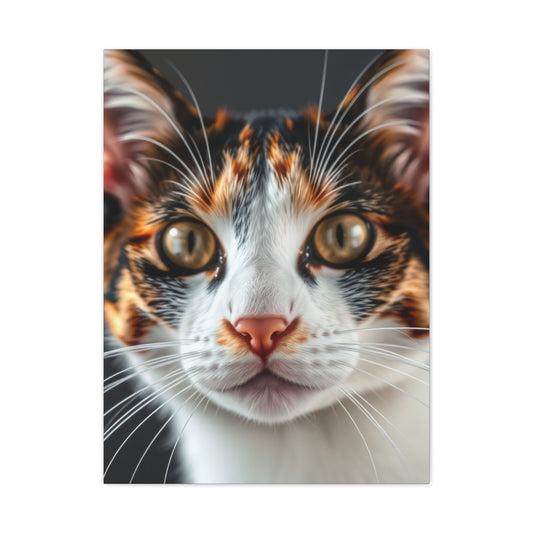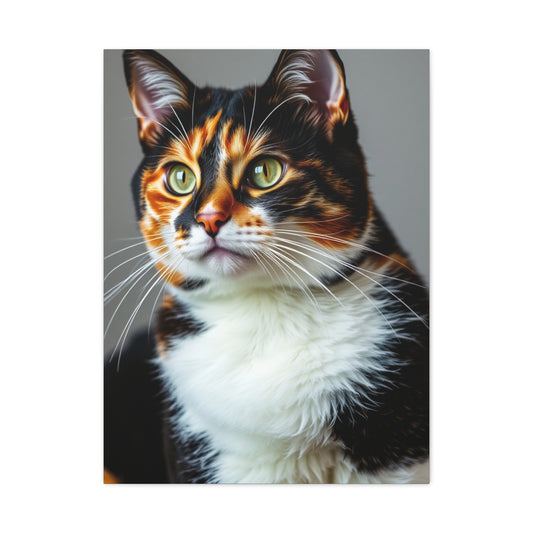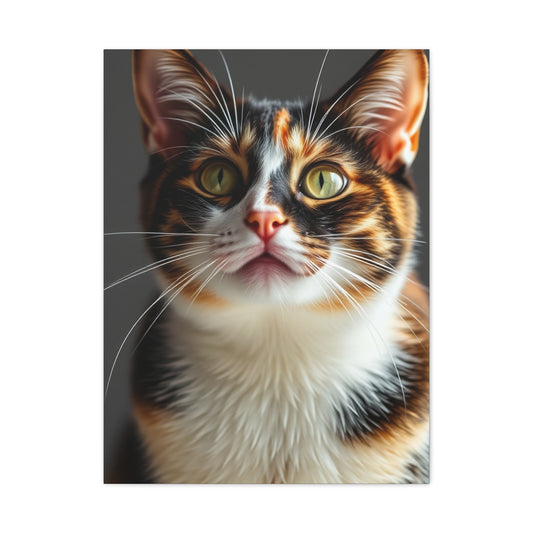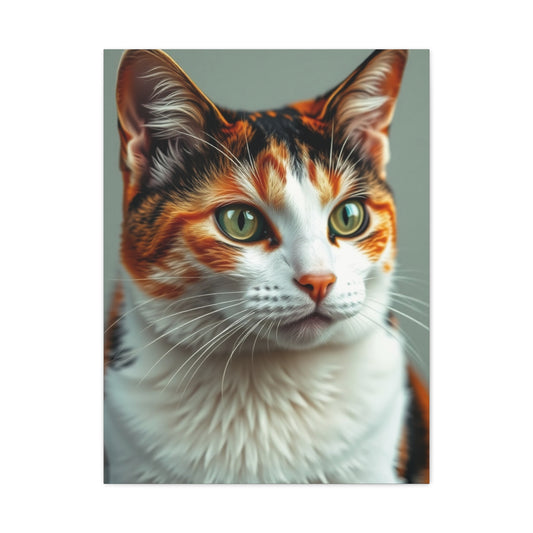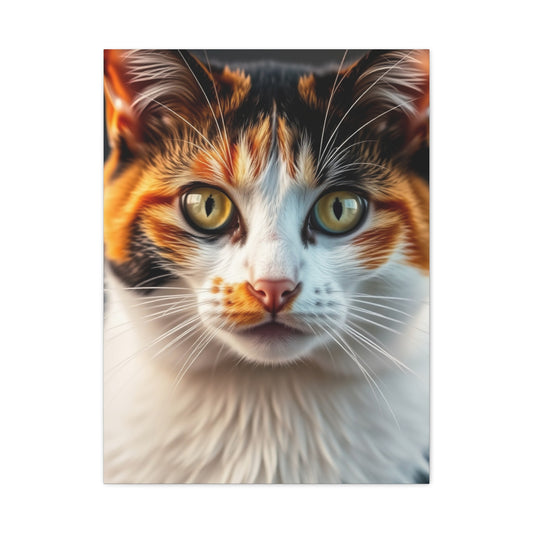Charming Calico Cat Watercolor Wall Art
Creating exceptional pet portraits is an art form that transcends simple representation. It demands extraordinary skill, boundless patience, and a profound understanding of the individual animal’s personality. Each pet carries a unique essence, a combination of physical traits and subtle behaviors, and capturing this essence in a medium like watercolor is both a challenge and a privilege. When commissioned to produce a watercolor rendering of Cleo, an extraordinary calico feline with a personality as vibrant as her patchwork fur, the artistic journey promised not only technical hurdles but also unparalleled creative fulfillment. This exploration delves into the sophisticated watercolor techniques, artistic methodologies, and creative processes essential for producing a portrait that transcends mere likeness and transforms into a timeless work of art.
Watercolor is a medium that thrives on delicacy and precision, yet it demands an element of spontaneity and fluidity that mirrors the very essence of life. Unlike oil or acrylic paints, watercolors are unforgiving in their transparency and unpredictability. Each stroke interacts with the paper, blending and bleeding in ways that are partly controlled and partly left to serendipity. For Cleo’s portrait, the challenge was to balance these forces, creating soft gradients that reflected the warmth of her fur while maintaining sharp details for her striking eyes, expressive whiskers, and distinctive calico markings.
Before any paint touched the paper, the process began with careful observation. Understanding Cleo’s posture, habitual expressions, and the subtle movements that defined her personality was essential. Photographs can provide reference, but a live study often reveals nuances that photos cannot capture—the tilt of a head when curious, the subtle lift of ears during alert moments, or the relaxed curl of her tail when content. These small gestures hold the key to conveying character, turning a technically accurate painting into a living representation that resonates emotionally with viewers.
Next came the preliminary sketching phase, which required both structural accuracy and artistic intuition. Using light pencil marks, the artist mapped out Cleo’s anatomy and essential contours. Proportions were carefully measured, yet enough flexibility was maintained to allow the painting to breathe and feel organic rather than rigid. This foundational work set the stage for the layering of watercolor washes, a technique that gradually built depth and luminosity. Multiple translucent layers were applied to emulate the softness of Cleo’s fur and the subtle interplay of light and shadow on her body.
Special attention was given to color harmony and blending. A calico cat’s coat presents a complex palette of oranges, blacks, creams, and whites. Achieving a balanced composition required precise mixing of pigments and controlled water application. The artist had to anticipate how colors would merge and dry, all while maintaining the integrity of Cleo’s unique markings. Highlights were preserved by careful lifting and masking, ensuring the fur retained its natural sheen and texture.
Finally, the portrait’s emotional resonance was enhanced through focused detailing on Cleo’s eyes and expression. Often considered the windows to the soul, a pet’s eyes convey intelligence, curiosity, and affection. Subtle glazes, careful layering, and tiny touches of white gouache were used to capture Cleo’s vibrant gaze, drawing viewers into her world and establishing an immediate emotional connection.
The culmination of this artistic journey is more than just a representation of a beloved pet. It is a celebration of character, a dialogue between artist and subject, and a testament to the transformative power of watercolor. The resulting artwork possesses a timeless quality, suitable for display in a home, gallery, or personal collection, serving as a daily reminder of Cleo’s charm, personality, and the profound bond between humans and their animal companions.
Creating a watercolor portrait of a calico cat like Cleo requires not only technical mastery but also empathy, observation, and dedication. Each step—from preliminary sketches to delicate washes and final details—demonstrates the intricate artistry involved in producing museum-quality pet portraits. For collectors, cat lovers, and art enthusiasts alike, such a piece transcends decoration; it becomes a cherished testament to both artistic skill and the irreplaceable individuality of the pet it immortalizes.
Calico Cat Characteristics and Artistic Interpretation
Calico cats possess distinctive tri-colored coats featuring magnificent combinations of white, orange, and black patches. These remarkable felines display unique genetic expressions that create stunning visual patterns impossible to replicate artificially. Each calico exhibits individual markings, making every portrait commission extraordinarily specialized and demanding meticulous attention to detail.
Professional pet portrait artists must comprehend feline anatomy, behavioral traits, and personality nuances before commencing artistic endeavors. Cleo represented particularly fascinating subject matter, demonstrating fierce independence, territorial instincts, and surprising gentleness toward neighborhood children. Understanding these personality dimensions influences artistic interpretation, color selection, compositional choices, and emotional resonance within finished artwork.
Calico coloration presents technical challenges for watercolor artists. Traditional watercolor techniques emphasize transparency and luminosity, requiring careful planning to achieve rich, saturated colors while maintaining delicate tonal relationships. Orange pigments tend toward opacity, black areas require strategic layering, and white sections demand preservation through masking or negative space techniques.
Preparation and Material Selection
Professional watercolor portraiture demands premium materials, proper workspace preparation, and strategic planning. High-quality watercolor paper provides essential foundation for successful paintings. Cold-pressed papers offer ideal texture for pet portraits, providing sufficient tooth for detailed work while maintaining smooth washes for background areas.
Pigment selection significantly impacts final results. Professional-grade watercolors contain higher pigment concentrations, ensuring vibrant colors and enhanced lightfastness. Essential colors for calico portraits include burnt sienna, raw umber, ultramarine blue, cadmium orange, ivory black, and payne's gray. These foundational pigments enable extensive color mixing capabilities while maintaining chromatic harmony throughout the composition.
Brush selection requires careful consideration of various techniques employed during portrait development. Round brushes ranging from size 2 through 14 provide versatility for detailed work and broader washes. Flat brushes prove invaluable for background applications and textural effects. High-quality natural hair brushes maintain superior water retention and point formation essential for precision work.
Preliminary sketching establishes compositional framework and proportional accuracy. Light pencil guidelines ensure proper placement of facial features, body positioning, and environmental elements. Professional artists typically employ transfer techniques or direct observation methods to achieve anatomical precision before applying watercolor media.
Innovative Background Development Techniques
Background selection profoundly influences overall compositional impact and emotional resonance. Medium blue-gray backgrounds provide excellent complementary contrast for warm calico coloration while suggesting atmospheric depth and visual sophistication. This particular tonal choice enhances orange and brown fur tones while creating harmonious color relationships throughout the composition.
Watercolor background application requires strategic planning to preserve delicate white areas, particularly whiskers and facial markings. Masking fluid provides temporary protection for fine details, allowing artists to apply broad washes without compromising precision elements. Alternative approaches involve careful negative painting techniques, working systematically around preserved areas.
The innovative inclusion of environmental context adds narrative dimension to pet portraits. Cleo's cardboard box environment presented unique creative opportunities for personalization and storytelling. Transforming generic packaging into customized elements demonstrates artistic versatility and client-focused attention to detail.
Creative lettering and graphic design elements require specialized watercolor techniques. Text applications demand steady brush control, consistent letterforms, and appropriate scale relationships. The playful "bombcat" logo addition showcases artistic humor and personal connection between subject and artist, elevating the portrait beyond mere representation toward meaningful artistic expression.
Sophisticated Color Theory and Mixing Strategies
Successful calico portraiture relies heavily on nuanced color relationships and sophisticated mixing techniques. Orange fur sections require careful balance between warmth and natural authenticity. Pure cadmium orange appears artificially vibrant in most lighting conditions, necessitating subtle additions of burnt sienna or raw umber to achieve realistic fur tones.
Gray areas present particular technical challenges in watercolor media. Achieving luminous grays without muddiness requires strategic color combinations rather than simple black-and-white mixtures. Ultramarine blue mixed with burnt umber creates warmer gray tones, while prussian blue and burnt sienna produce cooler variations. These subtle temperature differences enhance dimensional modeling and atmospheric perspective.
Black fur areas demand special consideration in watercolor techniques. Pure black pigment often appears flat and lifeless in pet portraits. Professional artists typically employ rich dark mixtures combining ultramarine blue, burnt umber, and payne's gray to achieve deep, luminous darks that maintain transparency and visual interest.
White areas require preservation techniques and careful surrounding color application. The pristine white watercolor paper provides maximum luminosity for white fur sections. Surrounding colors must be carefully controlled to prevent contamination while maintaining sharp edge definition where appropriate.
The Unique Charm of Calico Cats
Calico cats are not just visually stunning; they are renowned for their spirited and unique personalities. Characterized by their tri-color coat, typically a mix of white, black, and orange, calicos exhibit a mosaic of patterns, each as distinct as a fingerprint. This visual complexity is complemented by their temperamental traits, which can range from playful and mischievous to calm and affectionate. These qualities make calicos highly appealing subjects for artists seeking to capture more than just physical likeness—they offer an opportunity to convey spirit, attitude, and emotion.
The diversity of calico markings provides a rich palette for watercolor artists. Unlike a single-color cat, calicos require careful attention to detail, precision in color blending, and a sophisticated understanding of light and shadow. Each patch of color must be rendered in a way that maintains harmony while emphasizing the natural beauty of the coat. The challenge lies not just in replicating the pattern but in ensuring that the final portrait captures the essence of the individual cat, making each piece a one-of-a-kind work of art.
Watercolor as the Ideal Medium for Pet Portraits
Watercolor is uniquely suited to the art of pet portraiture because of its transparency, fluidity, and luminosity. Unlike oil or acrylic paints, watercolor allows for delicate layering, soft blending, and subtle gradation of tones—qualities that are essential when depicting the soft textures of feline fur. The medium’s unpredictability also mirrors the lively and sometimes whimsical nature of cats, where spontaneous brushwork can bring the subject to life in ways that rigid mediums cannot.
When painting a calico cat, artists must carefully balance control and spontaneity. The layering technique, often called glazing, involves applying multiple translucent washes, allowing each layer to dry before the next is added. This method creates depth, volume, and realism in the fur, while preserving the vibrant interplay of the three primary colors in the coat. Achieving this balance requires patience, skill, and an intimate understanding of how water and pigment interact on the paper.
The Artistic Process: From Observation to Masterpiece
1. Observation and Understanding
The creation of a compelling calico cat portrait begins with careful observation. Capturing the cat’s posture, expressions, and habitual gestures is crucial. Photographs provide a starting point, but live observation reveals subtle nuances—a twitch of the ear, a focused gaze, or a relaxed tail—that define the cat’s personality. Understanding these characteristics allows the artist to inject life into the portrait, making it more than just a representation but a true reflection of the cat’s spirit.
2. Preliminary Sketching
Once the artist has a thorough understanding of the subject, the next step is a preliminary sketch. Light pencil lines define the cat’s anatomy, proportions, and overall composition. In this phase, accuracy is essential, but so is flexibility. Overly rigid sketches can result in lifeless depictions, while loose, confident lines provide a foundation for dynamic watercolor application.
3. Layering and Wash Techniques
Layering is the cornerstone of watercolor pet portraits. Artists typically begin with light washes to establish base colors, gradually building intensity through successive layers. For calico cats, this means carefully separating patches of black, orange, and white while ensuring smooth transitions and natural blending. The use of wet-on-wet techniques can create soft fur textures, while wet-on-dry allows for sharper details such as the eyes, whiskers, and markings.
4. Attention to Detail
Detailing is where the portrait truly comes alive. The eyes, in particular, serve as focal points, conveying intelligence, curiosity, and emotion. Subtle highlights and reflections are carefully added to mimic light catching the cornea, giving the eyes depth and vitality. Fine brushes or even tools like masking fluid may be employed to preserve the integrity of small white areas or delicate fur strands.
5. Emotional Resonance
A successful calico cat portrait captures not just appearance but personality. Every brushstroke, wash, and detail contributes to a sense of life and presence. The cat’s unique quirks—the playful tilt of the head, the alertness in the gaze, or the softness of the resting posture—imbue the artwork with emotional resonance, allowing viewers to feel a connection to the subject even if they’ve never met the cat.
Styling Your Space with Calico Cat Watercolor Art
Calico cat watercolor art is more than a charming depiction of a beloved pet—it is a versatile, transformative element that can redefine the ambiance of any room. Its combination of artistic finesse and natural warmth allows it to serve as both a visual focal point and a subtle enhancer of interior spaces. From the soft wash of delicate watercolor tones to the vibrant tri-color markings characteristic of calico cats, each artwork offers unique possibilities for interior design, blending artistic expression with personality-driven décor. In this section, we explore in detail how calico cat watercolor art can be styled in a variety of spaces, offering creative inspiration for homeowners, office designers, and art enthusiasts alike.
Enhancing Cozy Living Rooms
One of the most natural settings for calico cat watercolor art is a cozy living room. The soft transparency of watercolor pigments complements plush textiles, warm lighting, and inviting furniture, creating a harmonious and comforting environment. Calico cats, with their playful yet serene expressions, add a touch of whimsy and warmth that enhances the sense of home. A single large-scale portrait hung above a sofa can serve as a central focal point, drawing attention while evoking feelings of companionship and joy.
To maximize the impact, consider pairing the artwork with complementary textiles such as cushions or throws that echo the painting’s color palette. Neutral-toned walls provide the perfect backdrop for watercolor art, allowing the vibrant oranges, blacks, and creams of a calico cat’s coat to pop without overwhelming the space. Layered lighting, including table lamps or strategically placed spotlights, can further highlight the soft gradients of watercolor, emphasizing the depth and dimensionality of the artwork.
Integrating into Modern Studios and Workspaces
Calico cat watercolor art is equally effective in modern studios or home offices. In such environments, where the design may lean toward minimalism or clean lines, the artwork can provide an organic and playful counterpoint to sleek furniture and neutral surfaces. A series of smaller calico cat portraits arranged in a grid or linear fashion along a wall can create a gallery-style effect, introducing character and warmth without cluttering the workspace.
In professional offices, calico cat watercolor art can serve as a conversation starter, bridging personal taste with a welcoming aesthetic. The soft textures and expressive details of watercolor make the paintings approachable, adding a sense of calm and creativity to an otherwise structured environment. To harmonize with modern décor, consider framing the artwork in thin metal frames or floating mounts that preserve the minimalistic theme while allowing the vibrant details of the cat’s coat to shine.
Creating Serene Reading Nooks
For spaces designed for relaxation, reflection, or leisure, such as reading nooks or meditation corners, calico cat watercolor art introduces an element of tranquility and emotional comfort. The gentle brushstrokes and transparent washes of watercolor naturally evoke a calming atmosphere, while the feline subject adds a relatable, comforting presence. A single portrait or a pair of complementary cat artworks can anchor a small corner, turning it into a personal retreat within the home.
Styling suggestions include pairing the artwork with soft furnishings in muted tones—cream, taupe, or pastel shades—so that the painting becomes the visual anchor. Surrounding the portrait with indoor plants, cozy rugs, or a low bookshelf can further enhance the space, creating a harmonious blend of nature, comfort, and artistry. The playful yet serene gaze of a calico cat captured in watercolor can transform a simple reading corner into a sanctuary of relaxation and inspiration.
Gallery-Style Arrangements and Large Wall Installations
For homeowners or collectors who wish to make a bold statement, gallery-style arrangements of multiple calico cat watercolor portraits provide an immersive and heartwarming experience. By grouping different poses, expressions, and sizes, the wall becomes a storytelling canvas that captures the multifaceted personality of the feline subject.
A large-scale installation can also create thematic cohesion in a living space. For example, portraits depicting playful antics, resting poses, or close-up expressions of calico cats can be arranged in a chronological or thematic sequence, allowing viewers to engage with the artwork as a narrative journey. This approach is particularly effective in larger rooms, such as expansive living areas, lofts, or studio apartments, where the artwork can occupy a significant portion of the visual field and define the room’s identity.
Complementing Décor with Frame and Mat Choices
The choice of frame and matting plays a critical role in integrating calico cat watercolor art into interior design. Minimalist frames in natural wood, white, or black allow the painting itself to shine, while more elaborate frames can add a touch of sophistication or vintage charm. For watercolor art, matting is especially important; it provides visual breathing room and prevents the colors from feeling cramped or overwhelmed by surrounding décor.
Natural wood frames work particularly well with calico cat portraits, complementing the earthy tones of the cat’s coat and evoking a sense of warmth and organic beauty. White or cream mats enhance the luminosity of the watercolor washes, making the colors appear brighter and more vibrant. For contemporary settings, floating frames or frameless mounts can create a modern, gallery-like presentation, emphasizing the artwork’s texture and brushwork.
Blending Art with Interior Themes
Calico cat watercolor art is highly adaptable and can be seamlessly incorporated into a wide range of interior themes. In Scandinavian-inspired spaces, the artwork’s soft tones and subtle details align perfectly with light wood, neutral palettes, and minimalist design. In eclectic interiors, the tri-color vibrancy of calico markings adds a playful, visually engaging element, complementing patterns, textures, and mixed materials.
Even in traditional or rustic interiors, watercolor portraits of calico cats can enhance the overall aesthetic by introducing warmth and organic charm. Placing the artwork near wooden furniture, exposed brick, or stone accents creates a cohesive blend of textures that highlight both the artistic skill and the natural beauty of the subject.
Layering and Styling with Complementary Decor
To maximize the visual and emotional impact of calico cat watercolor art, designers often use complementary decorative elements. Pairing the artwork with soft textiles, such as cushions or throws in muted or matching colors, enhances the warmth and cohesion of the space. Decorative objects like ceramic cat figurines, books, or subtle plant arrangements can further emphasize the theme without overwhelming the artwork.
Lighting is another key element. Natural light enhances the delicate transparency of watercolor, while adjustable LED or spot lighting can highlight specific details, such as the cat’s eyes or fur texture. This careful orchestration of light and surrounding décor ensures that the artwork remains the focal point, commanding attention while harmonizing with the overall aesthetic.
Personalization and Custom Commissions
Many homeowners opt for commissioned calico cat watercolor portraits to bring a truly personal touch to their space. Custom commissions allow for specific poses, expressions, and even background choices that reflect the personality of the pet or the intended ambiance of the room. Personalized portraits can become family heirlooms, treasured across generations, and serve as meaningful conversation pieces that blend art with emotional significance.
Choosing the Right Artist for Your Calico Cat Portrait
Commissioning a watercolor portrait of your calico cat is an investment in both artistry and sentimentality. Unlike mass-produced prints or generic pet illustrations, a commissioned watercolor portrait captures the individuality, personality, and charm of your feline companion in a way that no other medium can. However, achieving a truly remarkable result depends heavily on selecting the right artist. Choosing wisely ensures that the final portrait reflects not only your cat’s physical likeness but also the essence of its spirit, temperament, and quirks.
Understanding the Role of a Watercolor Artist
A skilled watercolor artist is more than someone who can reproduce shapes and colors on paper. Watercolor is a delicate and demanding medium that requires technical mastery, intuition, and an understanding of how light, texture, and transparency interact. When applied to a living subject such as a calico cat, these skills must be coupled with observational acuity and empathy. An accomplished artist can translate subtle movements, facial expressions, and posture into brushstrokes that convey life, energy, and personality.
Unlike oil or acrylic painting, watercolor is unforgiving in its transparency. Mistakes are difficult to correct, and layering must be carefully controlled to avoid muddiness or over-saturation. Therefore, an artist who is proficient in watercolors will demonstrate not only technical skill but also experience with techniques such as wet-on-wet blending, glazing, lifting, and masking. These methods allow for the soft gradations of fur, subtle color transitions, and luminous effects that make calico cat portraits appear lifelike.
Reviewing Previous Work
The first step in selecting an artist is reviewing their portfolio. A strong portfolio provides insights into the artist’s style, level of technical mastery, and ability to handle animal subjects. Look specifically for examples of cat portraits or other small mammals, paying attention to several key elements:
-
Fur Texture and Detail – Observe how the artist renders different fur patterns. Calico cats, with their tri-colored coats, require precise attention to color blending and layering. The transition between black, orange, and white fur should feel natural and harmonious, not abrupt or artificial.
-
Eyes and Expression – The eyes are the focal point of any pet portrait, conveying emotion, intelligence, and personality. Strong artists capture depth and liveliness through careful layering, glazes, and subtle highlights. The gaze should feel authentic, connecting the viewer emotionally with the subject.
-
Color Accuracy – Watercolor requires an understanding of how pigments interact. Evaluate how well the artist captures the unique shades of your cat’s coat while maintaining vibrancy and balance. Colors should feel organic, reflecting natural lighting and the nuances of fur.
-
Composition and Background – While the focus is on the cat, a well-composed portrait also considers background and context. Some artists include subtle environmental details, such as a favorite blanket, cushion, or outdoor setting, which enhance storytelling without distracting from the subject.
By examining these factors, prospective buyers can identify artists whose style aligns with their vision, ensuring the portrait will meet both aesthetic and emotional expectations.
Understanding Brush Techniques
Beyond reviewing completed works, it is helpful to understand an artist’s brush techniques. Watercolor artists employ a variety of strokes to convey texture, depth, and movement. For calico cats, this might include fine, hair-like strokes for detailed fur, broader washes for shadows, or soft blending to transition between color patches. Ask the artist about their approach: how they handle layering, how they maintain vibrancy in multi-colored coats, and how they capture highlights or reflective surfaces such as eyes and noses.
Some artists also use specialty techniques to enhance the portrait’s realism. For example, lifting pigment can create the illusion of light catching on fur, while dry-brushing can suggest texture and depth. An experienced watercolorist will combine these techniques seamlessly, resulting in a lifelike and emotionally resonant depiction.
Evaluating Emotional Expression
A technically proficient artist is essential, but capturing emotional expression is equally important. Your cat’s personality—whether playful, serene, or mischievous—should come through in the final portrait. Ask the artist how they study subjects: do they work from photographs, live observation, or a combination of both? Some cats have subtle quirks or characteristic gestures that define their personality, and an artist attuned to these details will incorporate them naturally.
Communication with the artist is critical at this stage. Sharing stories about your cat, favorite poses, or unique behaviors can help the artist infuse personality into the portrait. For example, a particular tilt of the head, the curve of the tail, or the way your cat interacts with its favorite toy can become signature elements of the artwork, making the piece uniquely yours.
Personalized Touches and Customization
One of the most compelling reasons to commission a portrait is the ability to personalize every aspect of the artwork. Customization goes beyond the cat’s likeness and extends to pose, expression, background, and even mood. Some common options for personalization include:
-
Favorite Poses – Sitting, curled up, stretching, or mid-play. Choosing a familiar pose helps convey the cat’s typical behavior and personality.
-
Environmental Context – Including a familiar blanket, cushion, garden, or window setting adds narrative depth.
-
Artistic Style – Watercolor portraits can range from highly realistic to softly impressionistic, depending on the artist’s approach and your preferences.
-
Color Enhancements – Some artists adjust tones subtly to harmonize with your room’s décor while maintaining the natural appearance of your cat.
Custom commissions ensure that the portrait is not only a representation of your cat but a reflection of the bond you share. Every detail contributes to the artwork’s uniqueness, making it a cherished and irreplaceable keepsake.
Establishing Trust and Communication
Choosing the right artist also involves evaluating professionalism, communication, and reliability. Commissioning a portrait is often a months-long process, and clear communication ensures your vision is accurately translated onto paper. Discuss timelines, revisions, reference photos, and any particular concerns you have before the project begins. Artists who are open to dialogue, provide updates during the painting process, and respond thoughtfully to feedback are more likely to deliver a satisfactory and emotionally resonant portrait.
Budget Considerations
Watercolor pet portraits are an investment. Prices vary based on factors such as size, complexity, artist experience, and level of customization. While it can be tempting to choose the lowest-cost option, consider the value of working with an experienced artist capable of capturing both physical accuracy and personality. A high-quality, carefully executed portrait will retain sentimental and artistic value for years, often becoming a treasured family heirloom.
Preservation and Longevity
An important consideration when commissioning watercolor art is longevity. Ask the artist about the type of paper, pigment, and framing recommendations they use. Archival-quality materials and proper framing will protect the artwork from fading, yellowing, or water damage, ensuring that your calico cat’s portrait remains vibrant and cherished for generations.
Care and Preservation of Watercolor Wall Art
Watercolor art, with its delicate textures, subtle color gradients, and luminous transparency, is one of the most enchanting mediums for capturing the charm of calico cats. However, the very qualities that make watercolor paintings visually captivating—its delicate paper fibers, light-sensitive pigments, and fluid color blending—also make it particularly vulnerable to environmental damage. To ensure that a watercolor portrait retains its vibrancy and emotional impact over time, careful consideration must be given to display, framing, and preservation practices. Proper care transforms a simple piece of art into a lasting family heirloom, allowing generations to enjoy its beauty and the memories it encapsulates.
One of the most critical factors in preserving watercolor art is protection from light exposure. Ultraviolet (UV) rays from sunlight can degrade pigments, causing colors to fade or shift over time. Even ambient light from windows or artificial sources can gradually alter delicate hues, diminishing the subtle vibrancy that defines watercolor paintings. To mitigate this risk, it is recommended to display artwork away from direct sunlight or bright, unfiltered light. If placement near windows is unavoidable, UV-filtering films on glass or specialized museum-grade protective glass in frames can significantly reduce exposure. These measures help maintain the fidelity of colors, ensuring that the calico cat’s distinctive coat patterns remain vivid and true to life.
Framing and matting play another vital role in protecting watercolor art. Acid-free mats act as a barrier between the painting and the frame, preventing contact with materials that may cause chemical reactions or staining. The mat also provides a small air buffer, reducing the risk of moisture accumulation or abrasion. Choosing frames with UV-protective glass or acrylic enhances this protection, shielding the artwork from both light and dust while allowing it to be safely displayed. Proper framing is not only a practical necessity but also enhances the visual presentation, creating a polished, gallery-quality look that complements the subject matter.
Environmental conditions, including temperature and humidity, are equally essential for the long-term preservation of watercolor art. Fluctuations in humidity can cause paper to expand and contract, leading to warping, buckling, or even pigment deterioration. Excessive moisture can encourage mold growth, while extremely dry conditions may make the paper brittle and prone to cracking. Ideally, watercolor paintings should be kept in spaces with moderate, stable humidity levels—around 40–50%—and a consistent temperature to prevent structural damage. Avoiding placement near heat sources, air conditioners, or damp areas is crucial to maintaining the integrity of the artwork over decades.
Regular maintenance and gentle cleaning further contribute to the longevity of watercolor wall art. Dust can accumulate on the frame or glass over time, and while it rarely reaches the painting itself if properly framed, light surface cleaning with a soft, dry cloth can prevent buildup. It is important to avoid using sprays, solvents, or water directly on the artwork, as these can cause irreversible damage. For older or particularly valuable pieces, professional conservationists can provide specialized care, including re-matting or reframing with archival materials, ensuring the portrait remains in pristine condition.
Conclusion
Charming calico cat watercolor wall art transcends mere decoration, serving as a profound celebration of beauty, personality, and the timeless bond between humans and their feline companions. Unlike conventional photographs or prints, watercolor portraits offer a unique interplay of color, texture, and artistic interpretation that captures the very essence of a pet’s character. Every brushstroke reflects the artist’s careful observation, from the subtle shifts in the cat’s tri-colored coat to the graceful curves of its posture. The layering of translucent pigments allows for depth and luminosity, highlighting the nuanced expressions, alert eyes, and gentle demeanor that make calico cats so endearing. Through these artistic techniques, watercolor portraits preserve not only the physical likeness but also the personality, energy, and spirit of the animal, creating a piece that resonates deeply on an emotional level.
For collectors, interior design enthusiasts, and devoted cat lovers alike, calico cat watercolor art offers more than aesthetic appeal; it serves as a repository of memories and emotion. A well-crafted portrait captures fleeting moments of curiosity, playfulness, or quiet companionship, allowing viewers to relive cherished experiences with their pets. The portrait becomes a silent storyteller, narrating the unique bond between human and feline while imbuing the surrounding space with warmth, charm, and life. This emotional connection is particularly meaningful for those who have lost a beloved cat, as the artwork preserves the essence of the pet and provides a tangible link to memories that might otherwise fade with time.
Cultural and symbolic significance further enhances the value of calico cat watercolor portraits. Across many societies, calico cats are considered auspicious symbols of good fortune, protection, and prosperity. Displaying a calico cat portrait in the home can therefore function as both a beautiful focal point and a subtle source of inspiration or positive energy. The artwork becomes a bridge between tradition and contemporary design, merging symbolic meaning with visual elegance. For those who appreciate the cultural lore associated with these unique felines, a watercolor portrait is not just art; it is an emblem of heritage, belief, and respect for nature’s intricacies.
From an interior design perspective, calico cat watercolor art is remarkably versatile. Its gentle, layered hues can complement minimalist, modern, eclectic, or traditional décor, while the vibrant tri-colored patterns of calico coats provide dynamic visual interest. Whether positioned as a single statement piece on a living room wall or integrated into a curated gallery of pet-themed or nature-inspired artwork, these portraits add personality, warmth, and sophistication to any environment. The soft fluidity of watercolor contrasts beautifully with hard architectural lines, creating harmony and balance within the space. Moreover, the scale and composition of the portrait can be adapted to suit different rooms, allowing for creative flexibility in both residential and professional interiors.
Importantly, these artworks serve as enduring reminders of the joy, companionship, and unconditional love that pets bring into human lives. Unlike digital images or temporary décor trends, a professionally executed watercolor portrait has lasting value—both emotionally and artistically. Its timeless quality ensures that it can be treasured for generations, potentially becoming a family heirloom that celebrates not only a beloved pet but also the skill, dedication, and vision of the artist who brought it to life.
In essence, calico cat watercolor portraits embody the perfect fusion of artistry, sentiment, and aesthetic charm. They capture the beauty, uniqueness, and playful spirit of one of nature’s most beloved creatures, while simultaneously enriching homes with visual elegance, warmth, and personality. Whether displayed prominently as a focal point or harmoniously within a collection of artwork, these portraits offer a lasting testament to the enduring human-animal bond, the emotive power of watercolor, and the timeless appeal of capturing life’s most cherished companions on paper. For anyone who has experienced the joy of sharing life with a calico cat, these paintings are more than art—they are an expression of love, memory, and the magic inherent in everyday moments with a cherished friend.

